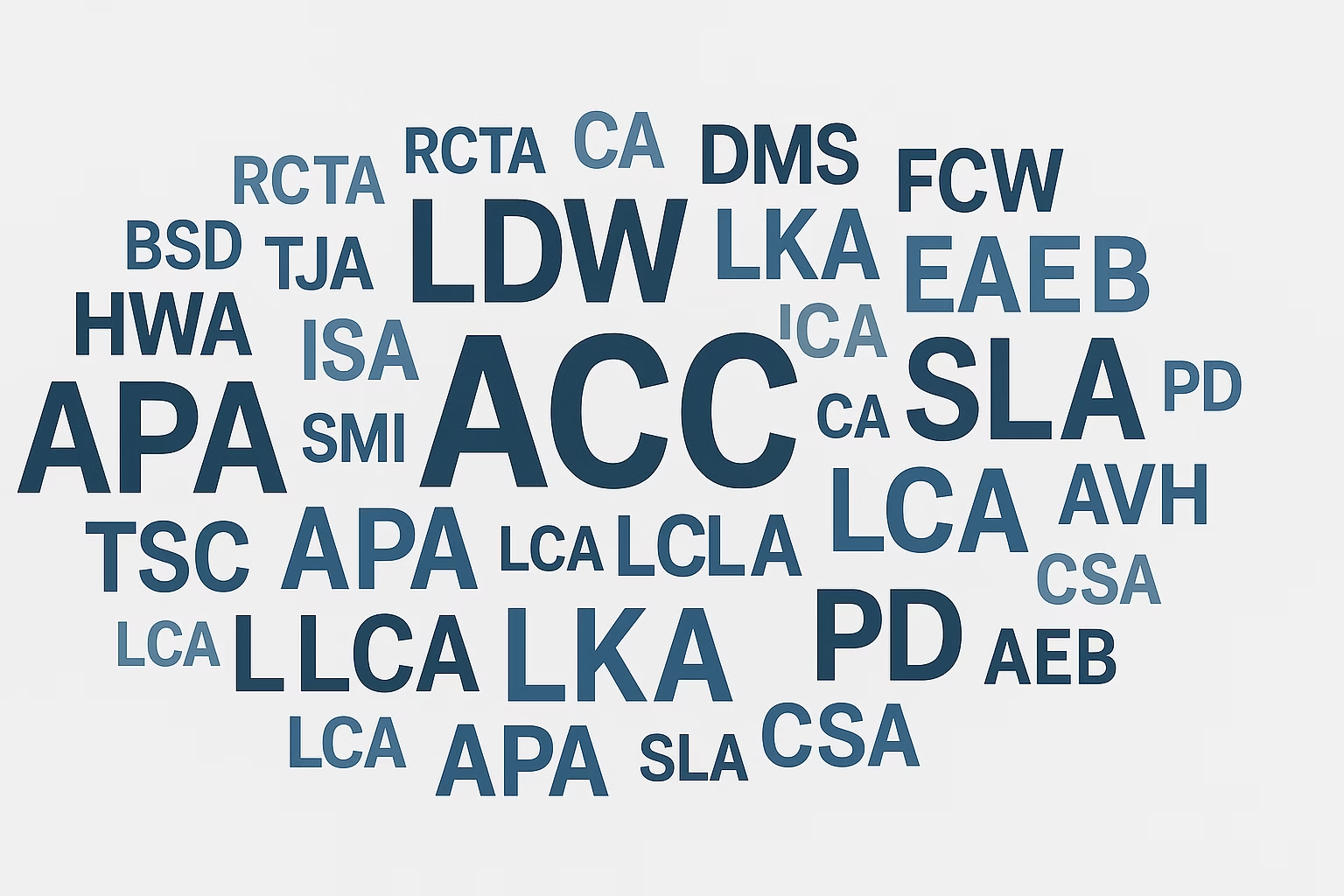Adaptive cruise control is one of the most helpful Advanced Driver Assistance System features in modern cars. It uses sensors and software to maintain a set distance from the vehicle ahead, adjusting your speed automatically. However, if you flip through car brochures you won’t see a universal term. Every manufacturer uses its own branding, which can make it confusing when you’re shopping for a new or used car. This guide breaks down the different names and what they mean so you know what to look for.
What is adaptive cruise control?
Before diving into names, it helps to understand the basic function. Traditional cruise control lets you set a fixed speed, which the car maintains until you brake or cancel it. Adaptive cruise control (ACC) takes this a step further by monitoring traffic ahead using radar, cameras or a combination of sensors. If the car in front slows, ACC reduces your speed to maintain a safe following distance. Once the lane is clear, it accelerates back to your pre‑set speed. Some systems can bring the car to a complete stop and resume automatically in slow‑moving traffic.
Having this feature reduces fatigue on long highway drives, eases the stress of stop‑and‑go commutes and encourages smoother driving. Importantly, ACC is still a support tool; you need to remain attentive and ready to take over at any time.
Common brand names and what they do
Subaru EyeSight
Subaru’s EyeSight is a suite of driver assistance features that includes adaptive cruise control. EyeSight uses stereo cameras mounted near the rear‑view mirror to detect vehicles, cyclists and pedestrians. When engaged on the highway, it keeps your car centred in its lane and adjusts speed to maintain distance. EyeSight is paired with pre‑collision braking and lane departure warning, giving Subaru vehicles a strong safety reputation. If you see a used Subaru advertised with EyeSight, it means you’ll have adaptive cruise functionality.
Toyota Dynamic Radar Cruise Control (DRCC)
Toyota offers several versions of adaptive cruise. Most models have Dynamic Radar Cruise Control, which uses millimetre‑wave radar and a camera to adjust speed. On newer vehicles equipped with Toyota Safety Sense 2.0 or 3.0, DRCC includes full‑speed range capability, allowing the car to stop and resume in traffic. The system is usually activated via a stalk behind the steering wheel, similar to regular cruise control. When reading Toyota brochures, look for phrases like “full‑speed range DRCC” or “all‑speed DRCC” to understand the capability.
Honda Sensing’s Adaptive Cruise Control (ACC)
Honda keeps things simple by naming the feature what it is. On vehicles with the Honda Sensing package, you’ll find Adaptive Cruise Control alongside Collision Mitigation Braking, Road Departure Mitigation and Lane Keeping Assist. Some models include Low‑Speed Follow, which, like full‑speed range systems, can handle stop‑and‑go traffic. When shopping for a Honda, check whether it has Honda Sensing; if so, adaptive cruise control is part of the bundle.
Mazda Radar Cruise Control (MRCC)
Mazda refers to its adaptive cruise as Mazda Radar Cruise Control. The system uses radar to maintain distance and can bring the car to a stop. On models equipped with Traffic Jam Assist, MRCC integrates with lane centring to provide semi‑autonomous driving in slow traffic. If you’re looking at a Mazda brochure, MRCC is typically listed under i‑Activsense safety features.
Ford Co‑Pilot360 and Lincoln Co‑Pilot360
Ford groups its driver assistance technologies under the Co‑Pilot360 banner. Adaptive Cruise Control with Stop & Go is available on many models, sometimes bundled with Lane Centring. Ford also offers Intelligent Adaptive Cruise Control on select vehicles, which uses speed limit sign recognition to adjust your set speed automatically. Lincoln, Ford’s luxury division, markets the same technology as Lincoln Co‑Pilot360. When reviewing spec sheets, look for these phrases to ensure you’re getting the adaptive functionality you want.
Volkswagen Travel Assist and ACC
Volkswagen names its basic adaptive cruise function ACC, short for Adaptive Cruise Control. On models equipped with Travel Assist (part of the IQ.Drive suite), ACC combines with lane centring to offer a more advanced experience. Travel Assist can handle stop‑and‑go traffic and has lane‑change assist on some models. If you’re comparing VW vehicles, note whether they have ACC alone or the full Travel Assist package.
Hyundai Smart Cruise Control
Hyundai and its sister brand Kia use the term Smart Cruise Control (SCC). Depending on the trim level and country, SCC may include Stop & Go and speed limit recognition. On newer models like the Hyundai Ioniq 5 or Kia EV6, Smart Cruise Control pairs with Highway Driving Assist to centre the car in its lane. As a shopper, look for SCC with Highway Driving Assist if you want a more hands‑free experience.
Nissan ProPILOT Assist
Nissan’s ProPILOT Assist is more than just adaptive cruise; it combines ACC with lane‑keeping to reduce driver workload on highways. The system can bring the car to a stop and resume in traffic. Nissan’s naming emphasises the semi‑autonomous nature of the feature. Some models use ProPILOT Assist 2.0, which allows hands‑free driving under certain conditions in Japan and the US. In Australia, you’ll generally find the first‑generation system.
Tips for recognising adaptive cruise control
- Look for branded suite names: Manufacturers often package ACC with other features. Names like EyeSight, Toyota Safety Sense, Honda Sensing, i‑Activsense, Co‑Pilot360 and Nissan Intelligent Mobility are clues that adaptive cruise is included.
- Check the steering wheel and stalks: ACC controls are typically on the steering wheel or a stalk. Buttons marked with a car icon and speedometer or distance bars indicate adaptive cruise. Photos in brochures can show this.
- Read the fine print: Not all systems are full‑speed range. Phrases like “with stop and go” or “Low‑Speed Follow” mean the car can handle traffic queues. Without these, the system may disengage below a certain speed.
- Ask about software updates: Some vehicles receive improvements via over‑the‑air updates. As we noted in our piece on how Chinese brands are changing the ADAS landscape, software focus is increasing. Updates can enhance adaptive cruise performance.
Why the names matter
Understanding the branding helps you compare vehicles objectively. One company’s fancy name might suggest a revolutionary feature, but in reality most adaptive cruise systems work on similar principles. Recognising the terminology allows you to focus on practical differences such as full‑speed capability, smoothness in operation and integration with lane centring.
If you’re unsure about a particular model, take it for a test drive. Engage the cruise control, set your desired speed and adjust the following distance. Notice how the car responds when another vehicle cuts in or slows down. And remember, even the most advanced systems are there to assist, not replace, the driver.
Looking ahead
As technology evolves, we can expect more descriptive and unified naming conventions. European regulations already require certain driver assistance features, and standardised terminology may follow. Until then, being familiar with brand‑specific names empowers you to make informed decisions.
For further reading on the broader market dynamics, check out our article on how Chinese brands are changing the ADAS landscape for drivers, which explains why these features are becoming more common. In our upcoming posts, we’ll also cover red flags to watch for when using ADAS and how to quickly disable these systems if you feel uncomfortable. Stay tuned to the Drivers Lounge for more plain‑English guides on getting the most out of your car’s technology.

Hiran Alwis is an automotive lecturer and ADAS specialist with over 15 years of experience in diagnostics, advanced safety systems, and technical training. He founded ADAS Project to help everyday drivers and workshop technicians understand and safely use advanced driver assistance systems.
